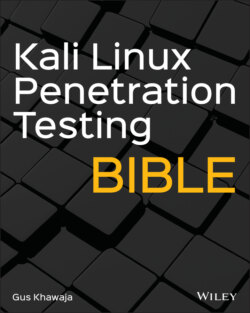Читать книгу Kali Linux Penetration Testing Bible - Gus Khawaja - Страница 54
Package Management
ОглавлениеThe first thing that you need to know before you update your Kali Linux system is that the configuration file for the Kali repository is located at /etc/apt/sources.list :
root@kali:/# cat /etc/apt/sources.list # # deb cdrom:[Kali GNU/Linux 2020.2rc1 _Kali-last-snapshot_ - Official amd64 DVD Binary-1 with firmware 20200505-14:58]/ kali-rolling contrib main non-free #deb cdrom:[Kali GNU/Linux 2020.2rc1 _Kali-last-snapshot_ - Official amd64 DVD Binary-1 with firmware 20200505-14:58]/ kali-rolling contrib main non-free deb http://http.kali.org/kali kali-rolling main non-free contrib # deb-src http://http.kali.org/kali kali-rolling main non-free contrib
To update your Kali Linux system (like Windows Update), execute the update command first and then the upgrade command. Take note, these two commands will use the earlier configuration file to download and install the necessary files:
$apt update $apt upgrade -y
We're using the ‐y option in the upgrade command to ignore the prompts where it asks for input. In other words, we're just saying “yes” in advance.
What is the difference between the upgrade and update commands? That's a confusing beginner question, and I'm here to help you start using these two commands with confidence. In summary, the update command only updates the package list with the latest versions, but it does not install or upgrade the package. On the other hand, the upgrade command will upgrade and install the latest version of packages that were already installed (using the update command).
Now, to use these commands together, you will have to use the && in between, which will eventually run the first command, and when it's done, it will run the second:
$apt update && apt upgrade -y
To fully upgrade from one release to another, execute the full‐upgrade command along with the update command.
$apt update && apt full-upgrade -y
Now, to list all the installed software packages on Kali Linux, you'll have to use the dpkg command:
$dpkg -l
What about installing a new software (package) on Kali? There are two common ways that I use most of the time. The first one is the apt install command, and the second one is dpkg (I use the latter only when I download a file that ends with .deb extension).
$apt install [package name] -y $dpkg -i [filename.deb]
In some software packages, they will require you to use the configure / make installation way, if that's the case, then use the following commands (you must be inside the application directory):
$./configure && make && make install
If you want to remove an existing application from your Kali system, then you use the apt remove command:
$apt remove [package name]
How do we find a package name? Let's say you want to install something that is not already installed on Kali. Then you can search the repository packages using the following command:
$apt-cache search keyword
Finally, if you want to install a package and you're not sure if the name exists in the repository, then you can use the apt‐cache show command:
$apt-cache show [software name] root@kali:/# apt-cache show filezilla Package: filezilla Version: 3.49.1-1 Installed-Size: 6997 Maintainer: Adrien Cunin <adri2000@ubuntu.com> Architecture: amd64 […]
